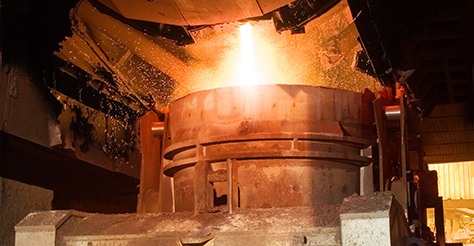-
Automated converter
In the converter of the steel shop, scrap and liquid hot metal are converted into liquid steel. This is done by blowing pure oxygen onto the liquid hot metal bath. During the process, carbon and other impurities are burned. This creates slag, a substance which floats on top of the liquid steel.
When the liquid steel is ready, we tilt the converter into a casting position and pour the fluid into a steel ladle through a tap hole. Afterwards, the convertor is tilted to the other side so that the slag can be poured into the slag pot via the vessel mouth. In order to increase the productivity of our convertor, we have automated the tapping process.
Slag free tapping
When tapping is concerned, the main challenge our steel shop faces is to separate as much slag as possible from the liquid steel. Basically, steel is tapped into a steel ladle and slag into a slag pot. However, to improve the process, the steel shop now also utilises a reststeel pot, which is placed next to the steel ladle on the transfer car underneath the converter.
Step by step explanation
What does the slag free tapping entail?
- The converter, which contains liquid steel and slag, is tipped over.
- First, the upper layer of slag is poured into the reststeel pot.
- As soon as the vessel reaches an angle of 80° and liquid steel is being tapped from the vessel, the transfer car automatically moves so that the centre of the steel ladle is positioned underneath the flow of the steel.
- When the scales on the transfer car indicates a weight of 270 tonnes, the transfer car repositions itself so that the liquid steel now flows into the steel ladle at its brim.
- Shortly afterwards, at a moment fixed by a mathematical model, the transfer car once again repositions until the tap hole is located exactly above the reststeel pot, which catches a mixture of slag and liquid steel.
- Finally, when only slag remains in the vessel, the vessel is tilted to the other side so that the slag can be poured into the slag pot via the vessel mouth.
The tapping process is controlled by a PLC (Programmable Logic Controller). This processor receives input from:
- The controls operated by the vessel operator
- The angle of the vessel
- The position of the steel transfer car
- The weight of the steel ladle and the reststeel pot
- Measurements of a mobile laser that calculates the content of the converter
- Temperature data from a pyrometer
Advantages of slag free tapping
Slag free tapping offers a lot of advantages. As is it is no longer needed to separate slag from the liquid steel after having been tapped, the run-through time of the process is shortened. This reduces energy and steel losses and it also reduces the number of crane manipulations. In short: Our productivity rises.
Furthermore, the profit on a safety level is enormous. During the oxygen blowing process, the liquid steel reaches a temperature of around 1,600° C. Thanks to the automation of the convertor process, our employees do not any longer have to be in the direct vicinity of the converter.
-
More on process innovation


